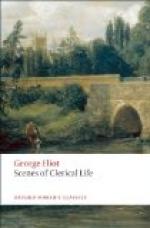What was thought of this problem, and of the man who had to work it out, by some of the well-to-do inhabitants of Shepperton, two years or more after Mr. Barton’s arrival among them, you shall hear, if you will accompany me to Cross Farm, and to the fireside of Mrs. Patten, a childless old lady, who had got rich chiefly by the negative process of spending nothing. Mrs. Patten’s passive accumulation of wealth, through all sorts of ‘bad times’, on the farm of which she had been sole tenant since her husband’s death, her epigrammatic neighbour, Mrs. Hackit, sarcastically accounted for by supposing that ’sixpences grew on the bents of Cross Farm;’ while Mr. Hackit, expressing his views more literally, reminded his wife that ‘money breeds money’. Mr. and Mrs. Hackit, from the neighbouring farm, are Mrs. Patten’s guests this evening; so is Mr. Pilgrim, the doctor from the nearest market-town, who, though occasionally affecting aristocratic airs, and giving late dinners with enigmatic side-dishes and poisonous port, is never so comfortable as when he is relaxing his professional legs in one of those excellent farmhouses where the mice are sleek and the mistress sickly. And he is at this moment in clover.
For the flickering of Mrs. Patten’s bright fire is reflected in her bright copper tea-kettle, the home-made muffins glisten with an inviting succulence, and Mrs. Patten’s niece, a single lady of fifty, who has refused the most ineligible offers out of devotion to her aged aunt, is pouring the rich cream into the fragrant tea with a discreet liberality.
Reader! did you ever taste such a cup of tea as Miss Gibbs is this moment handing to Mr. Pilgrim? Do you know the dulcet strength, the animating blandness of tea sufficiently blended with real farmhouse cream? No—most likely you are a miserable town-bred reader, who think of cream as a thinnish white fluid, delivered in infinitesimal pennyworths down area steps; or perhaps, from a presentiment of calves’ brains, you refrain from any lacteal addition, and rasp your tongue with unmitigated bohea. You have a vague idea of a milch cow as probably a white-plaster animal standing in a butterman’s window, and you know nothing of the sweet history of genuine cream, such as Miss Gibbs’s: how it was this morning in the udders of the large sleek beasts, as they stood lowing a patient entreaty under the milking-shed; how it fell with a pleasant rhythm into Betty’s pail, sending a delicious incense into the cool air; how it was carried into that temple of moist cleanliness, the dairy, where it quietly separated itself from the meaner elements of milk, and lay in mellowed whiteness, ready for the skimming-dish which transferred it to Miss Gibbs’s glass cream-jug. If I am right in my conjecture, you are unacquainted with the highest possibilities of tea; and Mr. Pilgrim, who is holding that cup in his hands, has an idea beyond you.




